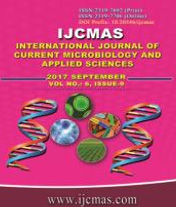


 National Academy of Agricultural Sciences (NAAS)
National Academy of Agricultural Sciences (NAAS)

|
PRINT ISSN : 2319-7692
Online ISSN : 2319-7706 Issues : 12 per year Publisher : Excellent Publishers Email : editorijcmas@gmail.com / submit@ijcmas.com Editor-in-chief: Dr.M.Prakash Index Copernicus ICV 2018: 95.39 NAAS RATING 2020: 5.38 |
Direct seeding and transplanting are the two methods of planting rice. The rice farmers practicing transplanting are facing problems like shortage of labour during peak time, hike in labour charges, small and fragmented land holdings etc. Direct seeding is becoming increasingly popular now days in India. The wet seeding of rice was adopted. Sprouted seeds were sown in puddle field 1-2 days after puddling using perforated drum seeder. Eight row direct paddy drum seeder tested manually drawn was used. The laboratory calibration was carried out with different combinations of drum fill level viz., full, half, quarter, and travel speed viz., 1 km/h, 1.5 km/h and 2 km/h. From the laboratory calibration test the combination of half drum fill level and 1 km/h speed were selected for field evaluation of drum seeder. The drum seeder was tested on puddle field. It was found from the study that, the theoretical field capacity was found 0.16 ha/h, while effective field capacity of the drum seeder was observed 0.131 ha/h. The field efficiency of the seeder was found 82.08 percent. The number of seeds dropped per hill was 5. The hill to hill spacing was 14.5 cm. The number of hills per square m was 30. The hill missing was 5.8 percent. The cost of operation of drum seeding is Rs. 42.67 per hour and Rs. 341.36 per ha. Seed rate was nearly constant for initial 10 m distance travelled. For the next successive points i.e. up to 20 m distance travelled seed rate was observed increasing continuously during actual field operation.
 |
 |
 |
 |
 |